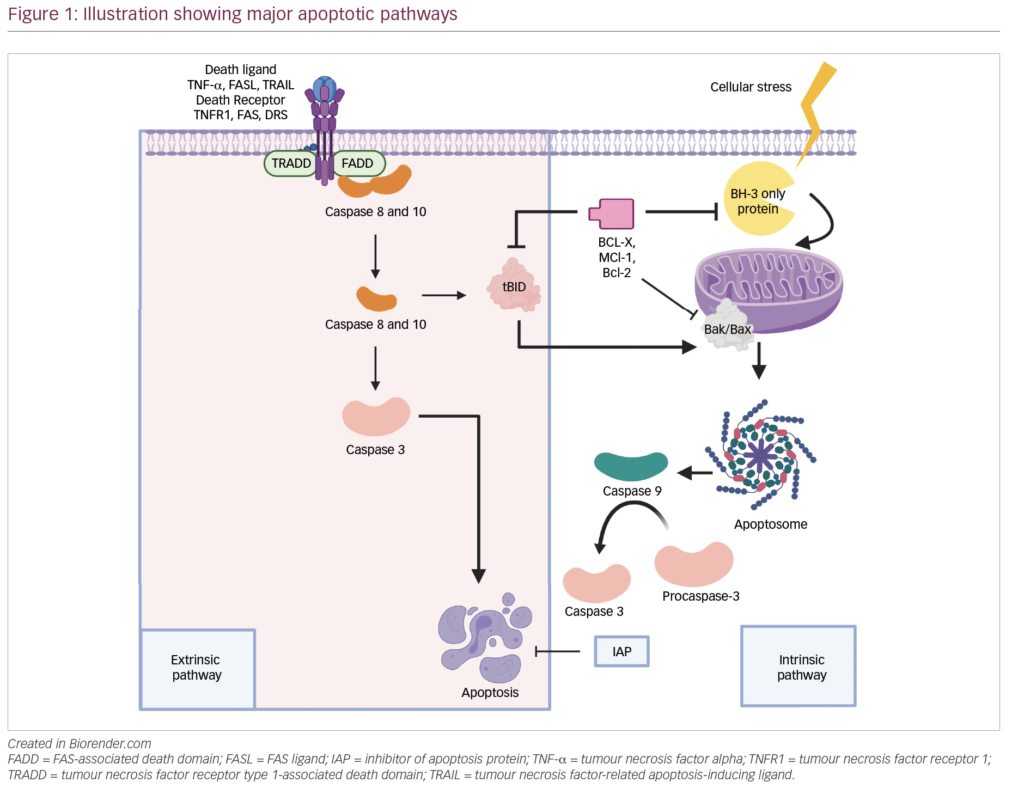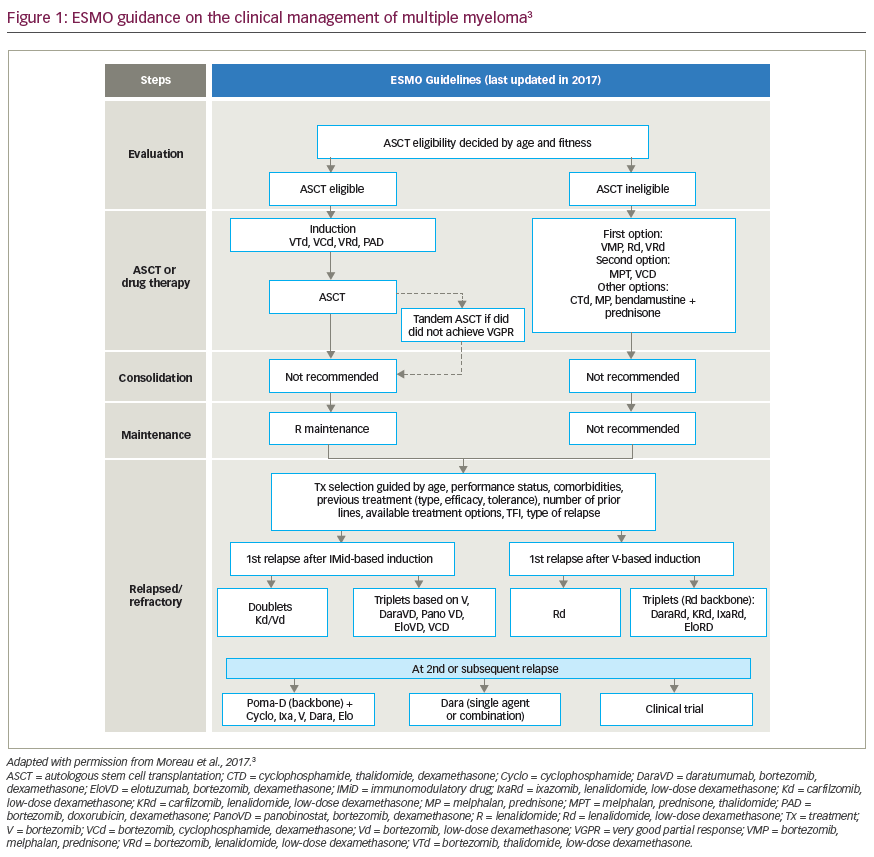Globally, multiple myeloma (MM) accounts for 0.8% of all cancer deaths, with a survival rate of 50% of those enrolled in clinical trials.1,2 It is the most common bone marrow cancer in Europe, with over 77,000 patients undergoing treatment at any one time.3 In the US, MM is the second most common haematological malignancy, affecting 4.4/100,000 people per year, with a male to female ratio of 1.4:1.4 The pre-malignant condition to MM – monoclonal gammopathy of undetermined significance (MGUS) – is present in approximately 3% of Caucasians over 50 years of age.5 Approximately 1% of MGUS patients will progress to MM or a related malignant condition each year.6 MGUS is defined by a monoclonal immunoglobulin (Ig) (M-protein) concentration of <30g/l, with the bone marrow containing less than 10% plasma cells and the absence of lytic bone lesions, anaemia, hypercalcaemia and renal insufficiency.7,8 To make a diagnosis of MGUS, laboratories have traditionally used serum protein electrophoresis (PEL) to detect the presence of M-protein and to characterise the type using immunofixation electrophoresis (IFE). However, 15–20% of MM patients have light chain MM (LCMM) and 3% have non-secretory MM (NSMM), which have small or undetectable amounts of measurable monoclonal protein in their serum with PEL.9–11 Highly sensitive serum free light chain (SFLC) assays are now available for clinical use; they allow quantification of free lambda (λ) and kappa (κ) chains. This new assay provides clinicians with an additional method of predicting prognosis of MGUS.
Laboratory Evaluation
In patients with no measurable monoclonal protein in serum or urine using the standard PEL test, SFLC assays are helpful. Unlike IFE, the SFLC assay is quantitative and, therefore, is more precise. In some cases, the bands produced in electrophoresis are not well defined and it can often be difficult to determine whether they indicate a low level of M-protein in the serum or show an oligoclonal variation. In this situation, an additional testing system would be beneficial. SFLC assays use polyclonal antibodies to measure the level of unbound κ and λ light chains in the serum by nephelometry. Light chains produced by the myeloma cells are either κ or λ. The result of the production of one SFLC and not the other will cause an abnormal κ–λ ratio. Normally, the ratio range is 0.26–1.65; however, if the level of free κ rises abnormally, the ratio will be shifted above 1.65, and vice versa. The M-protein has traditionally been measured using protein electrophoresis and IFE of a 24-hour urine collection. However, blood assays have clear advantages over urine tests from a physiological standpoint. SFLCs are cleared rapidly through the renal glomeruli and metabolised in the proximal tubules of the nephrons in the kidney. In normal patients, little or no SFLC is released into the urine and the level of SFLC has to increase many-fold before the absorption system is overwhelmed.12 Furthermore, samples need to be collected over a period of 24 hours, then concentrated in the laboratory. This procedure is inconvenient and time-consuming, and can be inaccurate.
Diagnostic Potential of Free Light Chain Assays
Early clinical studies for the SFLC assay were carried out in LCMM patients. In two studies, serum taken at the time of clinical presentation was analysed from 270 subjects and an abnormal SFLC ratio was noted in every case.13,14 Moreover, urine tests during chemotherapy may become normal, whereas serum analysis may remain abnormal, suggesting that the SFLC test has an increased sensitivity for residual disease. In this subset of patients, the SFLC assay may not correlate with the 24-hour urine test. By definition, patients with NSMM do not have detectable monoclonal protein by IFE in serum or in urine. Currently, diagnosis of NSMM is achieved through a bone marrow examination and the presence of other features of MM. In one study, 70% of 28 patients with NSMM showed an abnormal SFLC ratio.10
A more recent study evaluated five untreated patients with NSMM, all of whom had abnormal SFLC concentrations.15 The SFLC concentration in NSMM patients is below the detectable limit of the PEL and IFE. Thus, these patients can be monitored by the SFLC assay rather than the previously used tests.
The SFLC test also has a positive impact on the monitoring and detection of amyloidosis (AL). AL is characterised by fibrils consisting of monoclonal light chains deposited in various organs and tissues. The concentration of circulating SFLC is in many cases too low to be measured using PEL and IFE. However, in 90–95% of patients with AL, SFLC assays are able to quantify circulating monoclonal light chains.11,16 The SFLC assay allows the assessment of haematological responses in patients with a low tumour burden. Moreover, a combination of an abnormal SFLC assay or serum IFE analysis on serum samples from AL patients was present in 109 of 110 patients.15 The SFLC assay was abnormal in 91% of the patients; in comparison, IFE was abnormal in only 69% of the patients.
Monitoring Disease Progression
Serum concentrations of FLC and measurement of M-proteins by PEL are valuable in disease monitoring. This is of clinical value when tumours produce increased amounts of SFLC and small amounts of monoclonal-intact Ig. Patients who have been judged to be in remission by monoclonal IFE and PEL may still have abnormal levels of SFLCs, indicating residual disease. The SFLC assay has been used in the monitoring of MM progression after treatment.
Following chemotherapy, the level of SFLC has been shown to fall more rapidly compared with that of intact Ig in MM patients.17 SFLC concentrations also correlated better with bone marrow plasma cell assessments and serum beta (β)-2 microglobulin concentrations compared with Ig levels on PEL.17 These data suggest that SFLC assays follow the response to treatment in all MM patients. A later study confirmed this result and demonstrated that, after stem cell transplantation, over a period of 59 months SFLC concentrations decreased rapidly after treatment, whereas the PEL results took longer to respond.18
Similarly, in 137 AL patients the SFLC assay showed a decrease in SFLC concentration after treatment with high-dose chemotherapy or an intermediate-dose cytotoxic regime.11 In 86 patients, SFLC concentrations fell by >50%, which was linked to an 86% survival after five years, whereas in patients with a <50% fall in SFLC concentrations, five-year survival was 39%. The survival was unaffected by the type of chemotherapy used.11 Furthermore, in AL patients who had undergone peripheral blood stem cell transplantation, the assessment of the SFLC value provided a good indication of long-term survival, haematological response and organ response.19 The normalisation of the SFLC concentration after transplantation correlated with a positive response to treatment. Therefore, the SFLC assay is a useful tool for monitoring treatment in AL patients. A benefit of measuring SFLC is the short half-life of SFLC in blood. κ has a half-life of approximately two to three hours and λ has a half-life of five to six hours, which overall is approximately 150 times shorter than the 21-day half-life of Ig 1, 2 and 4, and approximately 50 times shorter than the half-life of Ig delta (Δ). Therefore, by using the SFLC assay the response to treatment can be seen rapidly in comparison with PEL.
Prognosis of Monoclonal Gammopathy of Unknown Significance with the Serum Free Light Chain Ratio
The risk of progression from MGUS to a malignant disorder does not diminish over time. The frequency of MGUS increases with age and, therefore, long-term follow-up is required with all MGUS patients. Clinicians are in need of biomarkers that can determine more accurately a patient’s risk of progression. The survival of MM is three to four years. Potential preventative agents are associated with serious adverse effects and only patients at a high risk of progression may be considered as candidates for a preventative treatment trial.
To date, risk factors that increase the likelihood of progression from MGUS to a malignant form have been difficult to identify. In an evaluation of 13 potential risk factors, the type of monoclonal protein, monoclonal protein size and an abnormal κ–λ FLC ratio were identified as the major risk factors for progression of MGUS.6,20 The risk of progression to MM 20 years after diagnosis with MGUS was 58% with all three risk factors (a monoclonal serum concentration of >1.5g/dl, the presence of Ig A monoclonal protein and an abnormal κ–λ ratio) in comparison with 5% if none of these risk factors were present.20 In another study, a bone marrow plasma cell concentration of 6–9% carried twice the risk of malignant progression than a concentration of ≤5%.21
Summary
In recent years, significant progress has been made in the diagnosis and assessment of patients with MM as well as pre-malignant conditions. The current gold standard of PEL to detect the presence of monoclonal proteins and IFE to determine its type is limited. The major problem of IFE is the interpretation in the laboratory. Even with a great deal of experience it can be difficult to determine whether the patient has a small monoclonal protein or whether there is an oligoclonal variation of the Ig. Moreover, IFE is a qualitative test. Serum FLC assays may be more helpful due to the greater sensitivity and quantitative nature of the assay. The use of serum FLC assays increases in the clinical assessment of patients with monoclonal gammopathies. Furthermore, the short serum half-life of SFLC shows promise in assessing response to therapy. ■














